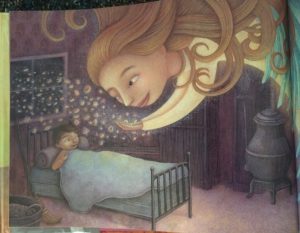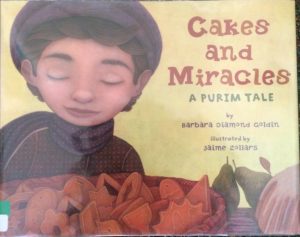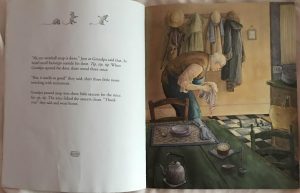Author: Barbara Diamond Goldin
Illustrator/Photographer: Jaime Zollars
Publisher and Year: Marshall Cavendish Corporation, 2010
Number of Pages: 30 pages
Genre: Realistic Fiction
This book is a storybook of a tale based on the Jewish holiday, Purim, which celebrates the biblical story of Ester. The main character, Hershel, is a blind boy that uses his imagination and special talents to help his mother bake cookies to sell at the local market for the Purim holiday. I believe that this story serves as a door because regardless of Hershel’s blindness, he has the opportunity to accomplish the same exact activities as people who can see. At the same time, the story serves as a window into the Jewish tradition by exposing and explaining to the reader the importance of the Purim holiday.
In the beginning of the story, Hershel was not given much power because he was blind and doubted by his mother. After Hershel’s visit by the angel, he gained power by proving he was helping his mother make beautiful cookies even though he could not physically see them. This story represents two cultures: the Jewish religion and people with disabilities. Purim is an important holiday that celebrates the survival of the Jews from persecution. This book honors and exposes the reader to the Jewish tradition and culture that might be unknown to many people. In addition, this story highlights the community of people with disabilities. Hershel was able to complete a task that was not “normal” for a blind child. For the reader, this book breaks the social norm that people with disabilities are incapable of contributing to the community. This story has shaped my understanding of culture by broadening my understanding of a new Jewish tradition that I was not familiar with. Through the illustrations, I was able to see interpretations of the Purim holiday, such as the cookies that are baked. In addition, the story illustrates a synagogue. By adding a picture of the synagogue, the reader is able to connect with the message of the story and emerge in the Jewish holiday of Purism visually as well as textually.
Perceptually, the text is on one side of the page suggesting the image is more important than the text. All images are unframed and close up which allows the reader to engage that much more into the story. The opening sentences of the story boldly state Hershel does things as the normal children do, foreshadowing that disability does not make a person with a disability incapable of every day tasks. Structurally, Jewish symbols such as the Star of David and menorah are used to honor and understand the Jewish culture. The mud symbolizes Hershel’s imagination and ability to have creativity. Dull and simple colors are used in the images, which can explain the hardship of Basha, Hershel’s mother, to take on both roles as a mother and father. It can also represent Hershel’s blindness of him not being able to see, but also explains the simplicity he experiences except in his dreams. In addition, the visual images of Hershel completing chores show he does not let disability stop him. The author of the book conveys these themes in the story through Hershel: disability does not limit an individual, holidays bring families and communities closer, and i imagination with determination can bring success.



